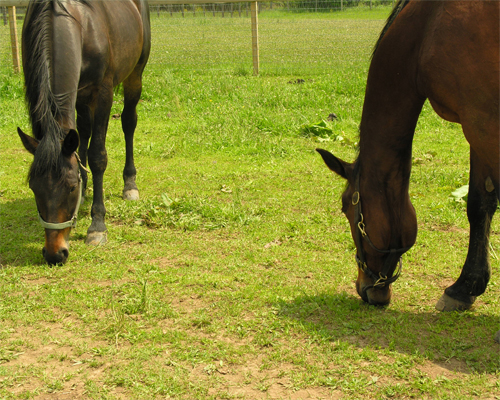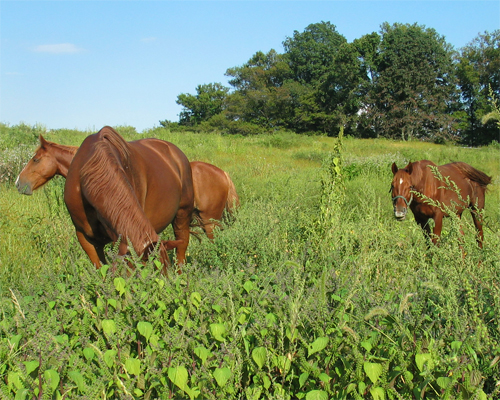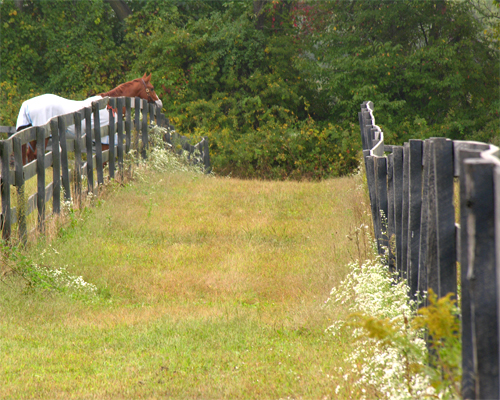
Fact Sheet FS938
Introduction
Hungry horses do not heed warnings about avoiding poisonous plants. There is widespread belief that instinct protects animals, but this is not always true. Therefore, it is up to horse owners to prevent plant poisonings. The best way to do this is to become familiar with identification of poisonous plants and pasture best management practices.
What makes a plant poisonous? There are several different chemical compounds capable of poisoning that can be found in a variety of plants. The chemicals range from the alkaloids, found in the nightshade family, to the glycosides, present in wild cherry and Sudan grass. The effects of plant toxins can range from mild irritation and weight loss to colic and possibly even death. Plant poisoning can often be difficult to diagnose, as it can resemble other physiological problems. Depending on the degree of plant toxicity, poisoning can occur due to a single contact (or ingestion) or long term repeated contact with a plant.
The degree of danger a poisonous plant represents is a function of the plant's prevalence, toxicity, and palatability. If good quality forage is plentiful in the pasture, horses will avoid most poisonous plants. In the absence of good quality forage, such as during periods of drought or when pastures are overgrazed, animals may begin to investigate undesirable plants available in the pasture. Fortunately, many poisonous plants are not palatable and horses will only eat them if adequate forage is not available.
Inspect Pastures
A primary way to avoid poisoning from plants is to walk the pastures and inspect for poisonous plants. If poisonous plants are present, they should be removed if possible (i.e. herbicide application, hand digging, or mowing) or excluded via fencing. Do not forget to inspect three or four feet beyond the fence line of the pasture, since many horses will stretch beyond the fence for forage. Walking the pastures will also give you an opportunity to evaluate the productivity of the pasture. Another thing to look for is the density of desirable forage species. Is adequate forage present for the horses, or does the pasture contain many bare areas (more than 30% of the field) without extra hay provided? Are there more weeds present than forage species? Also check the hedgerows surrounding the pasture. Many hedgerows contain wild cherry, maple, and black locust trees or seedlings which can be poisonous. Do not allow broken branches of these species to remain in the pasture, and avoid throwing shrub and tree prunings into the pasture. As listed below, many common shrubs and trees can be dangerous to horses.
Pasture Management
The best defense against poisonous plants is to promote good stands of desirable grass and legume species through a sound pasture management program. Pasture management should include soil testing, liming and fertilizing, good grazing management, mowing, and dragging (see FS368, "Establishing and Managing Horse Pastures"). Weed, insect, and disease control may also be required for pastures. A healthy, productive pasture will resist invasion from most poisonous weeds and provide good quality forage. When pastures are overgrazed, horses will eat the grass and legume species down to the soil, which allows weeds to take over.
Any plant that is not wanted in the pasture is a weed, and many weeds can be eliminated with good pasture management. Weeds can be controlled mechanically by mowing, culturally with good grazing management, or chemically with herbicides. Most poisonous plants are broadleaf plants or woody species. For general broadleaf weed control in pastures, the best results are obtained when weeds are actively growing. Dicamba, 2,4-D, or a combination of dicamba and 2,4-D may be sprayed in permanent pastures to control many annual and perennial broadleaf weeds while not affecting the grasses. However, dicamba and 2,4-D will kill or severely injure most legumes (i.e., alfalfa and clover). When using these herbicides, extra precautions should be used to prevent drift (airborne herbicide spreading somewhere other than the field being sprayed) and labeled information, specifically the grazing restrictions, must be followed.
Common Toxic Plants Found In or Near Horse Pastures
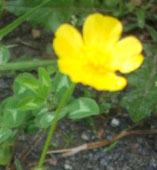
Tall buttercup. (Photo courtesy Sarah Ralston.)
Buttercups: The buttercup species (Ranunculus species) includes several annual and perennial plants which are commonly found in overgrazed horse pastures. Buttercup causes oral irritation when chewed, and horses rarely consume the plant because it is unpalatable. The toxic component is in the fresh leaves and flowers, but they lose toxicity when dried for hay. Symptoms of buttercup poisoning include increased salivation, decreased appetite, colic and diarrhea. In severe cases, poisoning may lead to convulsions and death. As long as horses have access to adequate pasture or hay, it is unlikely that they will eat buttercups.
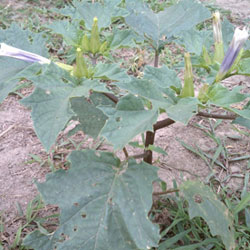
Jimsonweed. (Photo courtesy Carey Williams.)
Jimsonweed: Jimsonweed (Datura stramonium) is a worldwide nuisance. Other common names include Jamestown weed, thorn apple, downy thornapple, devil's trumpet, angel's trumpet, mad apple, stink weed and tolguacha. It is an annual plant, growing up to 5 feet tall in agricultural fields and overgrazed pastures. It can be recognized by its distinctive tree-like shape, white or purple trumpet-like flowers and prickly seed capsules. All parts of the jimsonweed plant are poisonous to horses and humans; toxicity is caused by tropane alkaloids. Symptoms of poisoning in horses include a weak, rapid pulse, dilated pupils, dry mouth, incoordination, diarrhea, convulsions, coma, and sometimes death. Jimsonweed has a foul odor and taste, and horses rarely consume it if they have other quality forage.
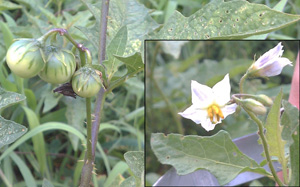
Horse Nettle. (Photo courtesy Carey Williams.)
Nightshade Family (including Horse Nettle): The nightshade family (Solanum species) contains many toxic plants, including horse nettle, black nightshade, bittersweet nightshade, some species of groundcherry, and even tomatoes and potatoes. They all contain a glycoalkaloid called solanine in the leaves, shoots, and unripe (green) berries. The plant affects the central nervous system and the gastrointestinal tract. Horses generally do not eat these plants unless they are very hungry and no other feed source is present. Toxicity is highest in green berries, followed by red or black berries, leaves, stems and roots. It is estimated that one to ten pounds of ingested plant material is fatal for horses. Some symptoms of solanine poisoning include dilation of pupils, diarrhea, loss of appetite, and loss of muscular coordination. Some other signs of poisoning are a sudden state of depression, apparent hallucinations, and convulsions.

Pokeweed. (Photo courtesy Sarah Ralston.)
Pokeweed: Pokeweed (Phytolacca americana) is a commonly found weed in horse pastures and around fence lines. It grows erect, resembling a tree, and can reach up to 10 feet in height. The stem is often purple or red in color and can reach a diameter of 4 inches. The leaves are long and elliptical, growing between 12 and 20 inches long. Pokeweed produces clusters of green berries, which mature to a dark purple color. The roots are the most toxic part of the plant, but horses can also be poisoned from the leaves and stems. A toxic compound, called phytolaccotoxin, can cause a burning sensation in the mouth, low grade chronic colic, and diarrhea. Pokeweed is not very palatable, so horses with access to plenty of good quality forage should avoid it.
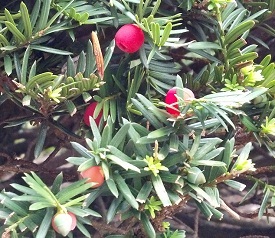
Japanese Yew. (Photo courtesy Carey Williams.)
Japanese Yew: Japanese yew (Taxus cuspidata) is an ornamental plant that is EXTREMELY toxic to mammals. It is grown as an ornamental shrub or hedge and has small evergreen leaves with bright red berries. Yew leaves have been reported to be palatable to horses, and as little as a mouthful (about 0.1% body weight of leaves) can be fatal within 30 minutes due to respiratory or cardiac collapse. Symptoms are rarely observed, as animals often die very quickly after ingesting this plant. Since it is a very common ornamental shrub, it is especially important to make sure neighbors do not throw yard clippings into your pastures.
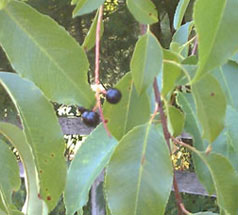
Wild Cherry Branch. (Photo courtesy Carey Williams.)
Wild Cherry: The entire Prunus genus (includes cherries, pears, and peaches) is toxic to horses and other livestock. The seeds, foliage, and bark produce hydrogen cyanide, a deadly compound. Leaves are most dangerous when wilted because the percentage of cyanide increases and leaves accumulate sugars as they wilt, but fresh leaves can also cause toxicity if enough are consumed. Two and a half pounds of black cherry leaves would be toxic to a 1,000-pound horse. Drought stress also increases cyanide levels. It is important to note that the small suckers that grow from the base of a cherry tree, even from cut stumps, contain high levels of cyanide.
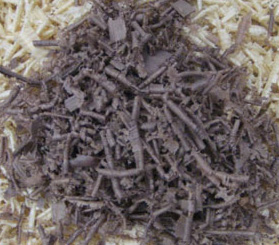
Black Walnut Shavings (dark) in regular pine shavings. (Photo courtesy Krishona Martinson, University of Minnesota.)
Black Walnut: The bark, woods, nuts, and roots of the black walnut tree (Juglans nigra) contains a toxic compound. There is conflicting research on exactly what the compound is; it was previously thought to be juglone, however juglone did not cause symptoms in experiments. Horses are primarily exposed through black walnut shavings mixed in with other shavings as bedding. Symptoms of exposure include depression, lethargy, laminitis, swelling of the lower limbs, and increased temperature, pulse, respiration rate, abdominal sounds, digital pulse, and hoof temperature. Symptoms usually disappear within hours after the horse is removed from the shavings; however laminitis can present further problems. Since the bark and nut hulls from the black walnut are toxic, these trees should be removed from horse pastures as a precaution.
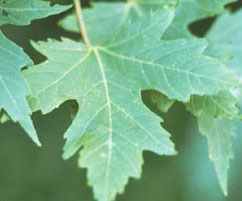
Red Maples Leaves. (Photo courtesy Krishona Martinson, University of Minnesota.)
Maple Trees: Maple (Acer species) leaves are highly toxic. However, usually this is when they are in the stressed state prior to dying (e.g. leaves on a fallen tree limb lying in a pasture or during the fall). Similar to wild cherry, the leaves are sweeter and more palatable when they are wilted. Fallen and dead leaves remain toxic for about a month and cause severe kidney damage if ingested in large quantities. It is estimated that an adult horse needs to consume 1.5 pounds of leaves or more to become poisoned. Symptoms of toxicity include depression, lethargy, increased rate and depth of breathing, increased heart rate, jaundice, dark brown urine, coma, and death.
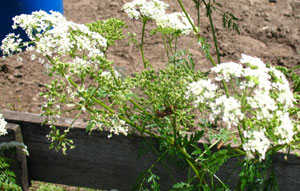
Poison Hemlock. (Photo courtesy Laura Gladney.)
Poison Hemlock and Water Hemlock: Poison hemlock (Conium maculatum) and water hemlock (Cicuta species) are both very toxic to horses. They are often found in moist areas and exude an unpleasant, parsnip-like odor when cut. While they look similar at first glance, they are different plants and have different toxic properties. All parts of the poison hemlock are toxic, and toxicity increases throughout the growing season, especially in the roots, which resemble parsnips. A horse must consume about 4 to 5 pounds of poison hemlock for the dose to be lethal. However, water hemlock is much more toxic, and even 8 ounces can be fatal to a horse. Toxicity of water hemlock decreases throughout the growing season; however, the roots remain highly toxic year-round. Both plants affect the central nervous system, and nervousness, trembling, and incoordination may be observed. Horses suffering from water hemlock poisoning typically become violent, with muscle tremors and convulsions. The plants can be differentiated by examining leaf shape: poison hemlock has many small fern-like leaves, and waterhemlock has large serrated leaves.
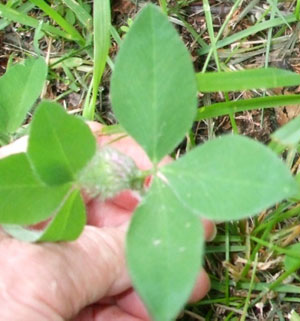
Alsike Clover (left) compared to red clover (right). (Photo courtesy Sarah Ralston.)
Alsike Clover: Alsike clover (Trifolium hybridum) is found most frequently in Canada, but has been included in some pasture mixes in the U.S. It grows to a height of 15 to 30 inches, and has a small ½-inch diameter pink flower that forms at the ends of secondary branches from the main stem. It should be differentiated from the non-toxic red and white clovers, which have a larger flower, hairy stems and leaves, and a white inverted "V" on the leaf. Alsike clover is known to cause two syndromes: photosensitization (short-term exposure) and "big liver syndrome" (long-term exposure) when infected with a mold. There is also a potential for nitrate poisoning. The more common and acute lesions related to photosensitization are characterized by reddening of the skin exposed to sunlight (especially on white markings), followed by either superficial or deep, dry necrosis of the skin and swelling and discharge, resulting in crusty inflamed areas. If the exposure is prolonged, the alkaloid toxin can cause acute liver failure, which can be fatal.
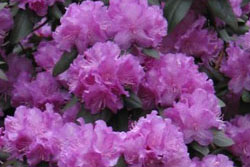
Rhododendron. (Photo courtesy Stan C. Hockanson, University of Minnesota.)
Rhododendron/Azalea/Mountain Laurel: Plants in the Rhododendron genus, such as azaleas, and other plants in the Ericaceae family, such as mountain laurel, are commonly planted as ornamentals for their colorful and attractive flowers. However, all parts of these plants contain glycosides called grayanotoxins which adversely affect the stomach, intestine, and cardiovascular system. The early symptoms are salivation, diarrhea, colic, and muscle tremors. Later, abnormal heart rate or rhythm may occur. If large enough quantities are eaten, this plant can cause death.
Some other toxic plants found in New Jersey include:
- Weeds: Onions/garlic, ground ivy, milkweed, bracken fern, cocklebur, horsetail, white snakeroot, St. Johns wort, star-of-Bethlehem, sorghum/sudangrass, yellow sweet clover, blue-green algae, bouncing bet, larkspur, mayapple, skunk cabbage
- Trees: Black locust, oak (green acorns), horse chestnut, boxwood, holly
- Ornamentals: Oleander, foxglove, tulips, day lilies, hydrangea, morning glory, iris, daffodil, lily of the valley, hyacinth, wisteria, trumpet vine, clematis, bleeding heart, Dutchman's breeches, English ivy, lupine, privet
These plants can often be easily identified using the online resources listed below. Many of the sites contain images to aid in identification. If you suspect a plant may be poisonous and need assistance identifying the plant, contact your county agricultural agent. The phone number for your Rutgers Cooperative Extension county agricultural agent may be found in the blue pages of your telephone directory, under County Government (or visit njaes.rutgers.edu/county).
References and Further Reading
Main photos by Carey Williams
May 2013
Copyright © 2024 Rutgers, The State University of New Jersey. All rights reserved.
For more information: njaes.rutgers.edu.
Cooperating Agencies: Rutgers, The State University of New Jersey, U.S. Department of Agriculture, and Boards of County Commissioners. Rutgers Cooperative Extension, a unit of the Rutgers New Jersey Agricultural Experiment Station, is an equal opportunity program provider and employer.


